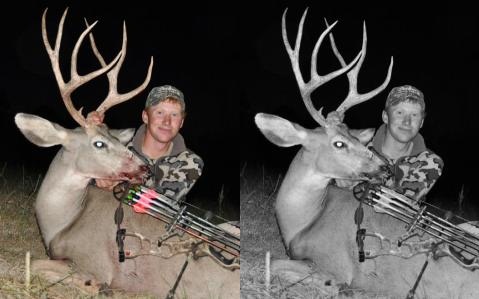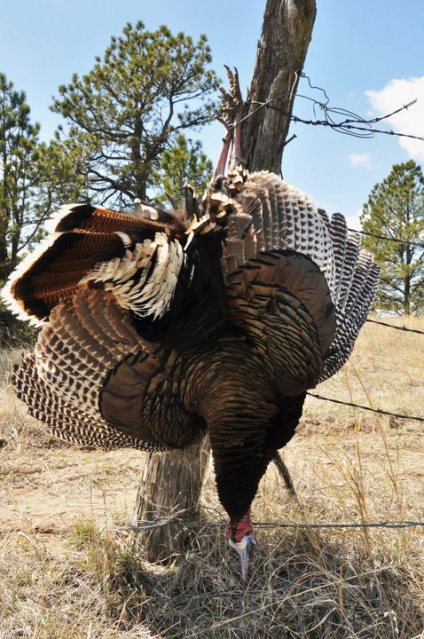Mastering “the Trophy Shot”
Adventurous Bowhunter 01.07.13

After a successful hunt every person likes to show off what they have harvested, and most of the time this is done with pictures. I believe that if a person is going to take a picture of an animal they harvested and show it to other people, they should take care in how they do it. I am not saying that all the pictures I take are perfect, because they are not, and I will critique them later, but I do my best to show respect to the animal.
There are lots of ways to take a good trophy shot, but there are a few definite ways to ruin them as well:
- Do not stand over the top of the animal. If possible get the animal (and its antlers if present) level with or above yourself.
- Lots of blood. Do your best to remove blood from the animal and from the ground around it if it is going to be in the shot. If you have access to water and a some sort of rag it is easy to clean off blood. Even a handful of grass or something can clean off blood, if it isn’t dry. Sometimes one side of the animal has more blood than the other, so take pictures of the clean side. Also, if the arrow is still in the animal make sure to remove it so it is not sticking out in the picture.
- Put the tongue back in. Sometimes it takes holding the bottom jaw to hold the mouth shut, I have even heard of people sewing the jaws shut to achieve this. If the animal is in rigor by the time pictures are taken, it can be hard to get the tongue back in, but cut it off if you have to.
Here is a picture of an antelope that I really like. One thing I like is how it is positioned. The body is facing the camera with the head turned. This shows off not only the horns, but also the markings on the antelope’s neck which I like. You can tell this buck had some blood around his mouth, which I mostly got washed off.
Here is another pronghorn picture, just taken from a different angle. One thing some people may say that would make this picture better is if I had used a fill flash when taking the picture. This would have removed the shadow from my face. I generally don’t like using a flash, and won’t if I don’t have to. The reason I don’t is because I don’t mind if my face is shadowed, and I don’t like how the flash makes an animal’s eye one big bright spot. I like a natural look. Another thing to note in this picture is the bloody mouth, I could have done better to clean that up. One other thing I did in this photo was to strategically place my bow. I like having it in the picture so usually I use it to cover things I don’t want to see. In this case the antelope was quartering away when I shot and the entrance is at the back of the rib cage. This dirty spot was pretty noticeable, but with the bow there it can hardly be seen.
The top picture of this doe is one of my favorites. I think it might be the black and white that I like, but also how the deer is set up and that the picture shows what it needs to show, and not any more. Compared to the first picture the second shows more of the doe, and is in color obviously. As with some of the others I have cleaned up the exit hole and placed my bow over it to make it less noticeable. One other thing about these two pictures is the background. Notice that it is way out of focus. This makes the subject stand out more, and makes for a better picture. This easiest way to do this is have the camera a ways away from the subject and then zoom in and focus on the animal, this will make the animal in focus and the background blurry.
The top picture of this elk shows how it died. This created a problem since I was by myself and could not move it around how I would have liked for better pictures. I did my best to roll him around and get him somewhat upright. You can also see on the trees to the right side of the picture that I trimmed some branches. Since I couldn’t move the elk I had to take the pictures right where he laid, and that meant clearing some branches so the elk was not blocked out.
These are two of my favorite turkey pictures. They show a couple different poses that I think work well for turkeys. The fan is usually the main focal point in these pictures so that is what I try to show off. In the top picture I am actually holding several tail feathers in place since they fell out when the turkey flopped around after getting shot. It wouldn’t have been a terrible thing to have some feathers missing in the picture, but I think it looks better this way. One thing that has always bothered me about the bottom picture is the couple of blades of grass right by the head of the turkey. I know that is getting pretty picky, but it would have been really easy to get rid of the grass and this is something that often needs to be done in trophy shots, especially for smaller animals.
These pictures show how if the animal does have some blood on it that the photo can be turned to a black and white and the blood becomes less noticeable. These also show why I don’t like using a flash, but I had to since it was dark out when I took those. I will just have to live with the deer’s eye being washed out.
A trophy shot does not have to be one with the hunter in the picture. Here are some “as it lay” and support photos that I like.
My best advice to take a good picture of your next trophy is to look at other people’s pictures, and when you see ones that you like take note of them and try to take pictures like them. This can’t always be done since every situation is different, but at least you will have some ideas on what you want to try. Also, take the time to take these pictures. I am not saying take and hour to do it, 15-30 minutes should be plenty. Take plenty of pictures and from several different angles and positions. You and others will look at these pictures for years to come hopefully, so do your best.
More tips on hunting photography can be found at http://adventurousbowhunter.com/.
![]()













